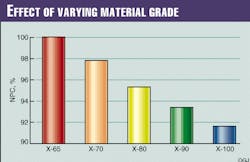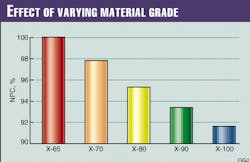Norman SandersonA collaborative program is being carried out by BG Technology, Shell Global Solutions, and BP Exploration to assess the potential of high strength, Grade X-100 steel line pipe for reducing the costs of pipelines for gas transportation.
BP Exploration Operating Co. Ltd.
Sunbury-on-Thames, U.K.
Rob Ohm
Shell Global Solutions
Amsterdam
Mike Jacobs
BG Technology U.K.
The 3-year program includes comprehensive material testing of prototype UOE SAW X-100 line pipe obtained from four manufacturers. Reported here is the accompanying techno-economic assessment showing the commercial advantages of using X-100 line pipe.
The results suggest potential cost savings from use of higher strength line pipe for large-diameter gas pipelines in remote environments where societal and environmental risks are low.
The experimental program contains the following elements:
- Metallographic characterization of pipe body and seam weld including tensile, Charpy-V notch, crack-tip opening depth, and drop-weight tear testing
- Ring-tension tests and full-scale hydraulic burst tests to assess parent-metal defect tolerance with slot defects of both finite and infinite length
- Ring-tension tests supplemented with state-of-the-art fracture mechanics to assess the tolerance of the material to defects in the heat-affected zone of the seam weld
- Girth-welding trials
- Review of ductile fracture-arrest capability.
The work also assesses the sensitivity of the optimal solution to variations in material, unit costs, and other base parameters.
Pipeline system
The characteristics of the pipeline system were selected to maximize the potential benefits of using high-strength steel. In populated regions, societal and environmental risk concerns can dominate wall-thickness selection and affect potential benefits.It was therefore decided to consider a single pipeline routed 1,000 km through open flat desert terrain, typical of some regions in North Africa. The desert is flat open land with soils which will not have an adverse impact on the progress of trenching. It is assumed that there are no permanent habitations along the pipeline route.
The remaining assumptions are as follows:
- The pipeline transports 20 bcm/year of commercial-grade natural gas. The actual composition was selected following a review of international gas specifications (92.8% methane, 3% ethane, 2.3% nitrogen, etc.). The gas is adequately conditioned to prevent drop out of condensate or water giving negligible internal corrosion of the pipeline.
- Design life is 30 years.
- The entry and delivery pressures are both 50 barg (725 psig).
- The compression facilities include a station at entry to the pipeline and up to four intermediate stations. For simplicity, it is assumed that the compression stations are spaced equally along the pipeline.
- The wall thickness is in accordance with ASME B31.8, with a design factor of 0.72. A maximum outside diameter/wall thickness (D/t) ratio of 100 is assumed to satisfy construction concerns. The effect of using higher design factors is also assessed in the parametric study.
Spreadsheet workbook
The workbook consists of 10 linked Excel spreadsheets used with a "table" command to allow multiple parameter optimization calculations to be performed. The calculations include:- Calculation of gas flow and thermal properties for compositional input including critical temperatures, specific heat, calorific value, molecular weight, etc.
- Calculation of the pressure drop and end conditions of each pipeline section
- Calculation of the initial and intermediate compressor-station characteristics assuming a single-machine sparing philosophy. The calculation included the selection of several actual commercially available compressor/
- Sizing of pipeline diameter and wall thickness
- Pipeline and compressor station CAPEX
- Pipeline and compressor station OPEX.
Cost basis
Table 1 [3,386 bytes] gives the relative costs of line pipe for each material grade. It is assumed that X-65 would be $836/metric ton delivered to country. The influence of variations in the cost between $600/metric ton and $1,000/metric ton is also assessed in the parametric evaluation.To assess the influence of higher strength materials on the pipelay aspects of the construction costs, the analysis includes a construction-material factor and uses a direct multiplier on the pipelay. It was assumed that X-100 line pipe would be 5% more expensive to install than X-65 and X-70.
The parametric study also assesses the effect of both no additional expense and 10% additional expense.
Total installed cost of the compression facilities derives from the following equation obtained from rationalization of a number of representative compressor-station cost estimates and includes turbines, compressors, station equipment, bulk materials, electrical, structures, etc.:
X = 24589 x Y -0.4212
where:
Y = The gas turbine driver unit cost, $/kw
X = The ISO power rating, kw
The pipeline-operating costs are taken as 1% of the total line pipe and coating material costs from experience of Algerian pipelines.
The compressor station-operating costs are based on manpower and material cost estimates for operations, planned maintenance and major equipment inspection, maintenance, and overhauls over a 30-year operational life.
Additional factors included are increase in facility requirements during manufacture and installation, construction camps and infrastructure, local taxes, and contingency.
Calculation method
The assessment is performed with an Excel spreadsheet workbook, combined with a "table" command to allow multiple parameter optimization calculations to be performed to achieve a minimum NPC for a given line pipe material yield stress.The calculated parameters include the following:
- Gas flow and thermal properties
- Pressure drop and end conditions
- Compressor station characteristics assuming a single machine sparing philosophy.
- Pipeline diameter and wall thickness
- Pipeline and compression capital expense (capex)
- Pipeline and compression operating expense (opex).
Approach
The work is being performed in two phases:- Cost optimization. With the base-case values of the input parameters, the optimum pipeline system design for the minimum NPC is determined for each of the material grades X-65, X-70, X-80, X-90, and X-100.
- Parametric study. For X-100 material grade, the influence of varying each of the input parameter values is determined with all other parameters constant. As before, the optimum system design for the minimum NPC is determined.
- Steel costs ($600/metric ton, $945/metric ton, and $1,200/metric ton)
- Design factor (0.72, 0.8, and 0.9)
- Real discount rate (4%, 7%, and 10%)
- Pipeline maintenance (0.5% and 1% of pipeline and coating material cost/year)
- Construction material factor for X-100 (1, 1.05, and 1.1)
- Fuel costs ($3/MMBTU and $6/MMBTU).
Results
Fig. 1 summarizes the results of the cost optimization exercise and shows the effect of varying material grade on the NPC of the optimized pipeline system using the base-case parameters.The effect of using higher-grade line pipe on the optimized system design is a reduction in pipeline diameter (capital expense) and an increase in the operating pressure level with a corresponding increase in the compression requirements (operating expense), as shown in Table 2 [7,694 bytes].
Fig. 2 [24,790 bytes] shows the effect on the system NPC of variation in steel prices between $600/metric ton and $1,200/metric ton. The effect on the system design is to increase pipeline diameter with reduction in steel cost.
Fig. 3 [17,116 bytes] shows the effect on the system NPC of increases in the design factor from 0.72 to 0.8 and 0.9. This indicates the likely effect of using the reliability-based limit state design techniques to optimize the pipeline wall thickness.1 The effect on system design of increasing design factor is to reduce diameter and increase operating pressure.
The remaining parameter investigations indicate that modest variations in pipeline maintenance, construction material factor, or increased fuel costs do not significantly change the system design or NPC.
Reference
- Zimmerman, T.J.E., Cosham, A., Hopkins, P., and Sanderson, N., "Can Limit States Design be used to Design a Pipeline above 80% SMYS," presented to International Conference on Offshore Mechanics and Arctic Engineering, Lisbon, July 1998.
The Authors
Norman Sanderson is practice area leader for SPR Pipeline Engineering in BP Exploration and has been involved in BP projects for the past 18 years in onshore and offshore pipeline engineering, operational support engineering, and technology development. He is a chartered engineer (U.K.) with extensive pipeline, production, petrochemical, and process industries experience for more than 33 years. Sanderson received a PhD from the University of Manchester Institute of Science and Technology in Applied Mechanics.
Rob Ohm is a senior research engineer with Shell Global Solutions, Shell Research & Technology Centre, Amsterdam. He has worked on the assessment and introduction of such newly developed materials as weldable 13%Cr pipe and high-strength line pipe. He holds an MS in mechanical engineering and metallurgy from the Technical University, Twente, Holland.
Mike Jacobs is project manager in facilities engineering BG Technology (formally the British Gas Research & Technology division), which he joined in 1984. He began his career as an apprentice with BP Chemicals in 1974. He holds a first-class honors degree in mechanical engineering (1982) from the University of Wales.
Copyright 1999 Oil & Gas Journal. All Rights Reserved.






